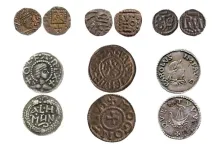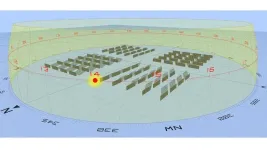(Press-News.org) University of Cambridge media release
Early medieval money mystery solved
UNDER STRICT EMBARGO UNTIL 00:01 AM (UK TIME) ON TUESDAY 9TH APRIL 2024
Byzantine bullion fuelled Europe’s revolutionary adoption of silver coins in the mid-7th century, only to be overtaken by silver from a mine in Charlemagne’s Francia a century later, new tests reveal. The findings could transform our understanding of Europe’s economic and political development.
Between 660 and 750 AD, Anglo-Saxon England witnessed a profound revival in trade involving a dramatic surge in the use of silver coins, breaking from a reliance on gold. Around 7,000 of these silver ‘pennies’ have been recorded, a huge number, about as many as we have for the rest of the entire Anglo-Saxon period (5th century – 1066).
For decades, experts have agonised over where the silver in these coins came from. Now a team of researchers from the Universities of Cambridge, Oxford and Vrije Universiteit Amsterdam have solved that mystery by analysing the make-up of coins held by the Fitzwilliam Museum in Cambridge.
The journal Antiquity publishes their study today. Co-author Rory Naismith, Professor of Early Medieval English History at the University of Cambridge, said:
“There has been speculation that the silver came from Melle in France, or from an unknown mine, or that it could have been melted down church silver. But there wasn't any hard evidence to tell us one way or the other, so we set out to find it.”
Previous research has tested coins and artefacts from the silver mine at Melle but Naismith and his colleagues turned their attention to less-studied coins which were minted in England, the Netherlands, Belgium and northern France.
Helpfully, Naismith had “a powerhouse of early mediaeval numismatic research” on his doorstep: The Fitzwilliam Museum.
To begin, 49 of the Fitzwilliam’s coins (dating from 660 to 820 AD) were taken to the laboratory of Dr Jason Day in Cambridge’s Dept. of Earth Sciences for trace element analysis. Next, the coins were analysed by ‘portable laser ablation’ in which microscopic samples were collected onto Teflon filters for lead isotope analysis. This is a new technique, pioneered by the Vrije Universiteit Amsterdam, which combines the minimally invasive sampling of laser with the high precision results of more traditional methods in which physical samples of silver are taken.
While the coins mostly contained silver, the proportion of gold, bismuth and other elements in them guided the researchers to the silver’s previously unknown origins. Different ratios of lead isotopes in the silver coins provided further clues.
The analysis revealed two major findings:
1. Byzantine silver
In the 29 coins tested from the earlier period (660 – 750 AD) – which were minted in England, Frisia and Francia – the researchers found a very clear chemical and isotopic signature matching 3rd to early 7th century silver from the Byzantine Empire in the eastern Mediterranean.
The silver was homogenous across the coins and characterised by high gold values (0.6 – 2%) and a consistent isotopic range, with no distinguishable regional variations among them. No known European ore source matches the elemental and isotopic characteristics of these early silver coins. Nor is there any meaningful overlap with late Western Roman silver coins or other objects. These coins did not recycle late Roman silver.
Naismith said: “This was such an exciting discovery. I proposed Byzantine origins a decade ago but couldn’t prove it. Now we have the first archaeometric confirmation that Byzantine silver was the dominant source behind the great seventh-century surge in minting and trade around the North Sea.”
The study’s lead author, Dr Jane Kershaw, from the University of Oxford, said: “These coins are among the first signs of a resurgence in the northern European economy since the end of the Roman Empire. They show deep international trade connections between what is now France, the Netherlands and England.”
The researchers emphasise that this Byzantine silver must have entered Western Europe decades before it was melted down because the late 7th century was a low point in trade and diplomatic contacts.
Naismith said: “Elites in England and Francia were almost certainly sitting on this silver already. We have very famous examples of this, the silver bowls discovered at Sutton Hoo and the ornate silver objects in the Staffordshire Hoard.”
Together, Sutton Hoo’s Byzantine silver objects weigh just over 10kg. Had they been melted down they would have produced around 10,000 early pennies.
Kershaw said: “These beautiful prestige objects would only have been melted down when a king or lord urgently needed lots of cash. Something big would have been happening, a big social change.”
“This was quantitative easing, elites were liquidating resources and pouring more and more money into circulation. It would have had a big impact on people’s lives. There would have been more thinking about money and more activity with money involving a far larger portion of society than before.”
Naismith hopes to establish how and why so much silver moved from the Byzantine Empire into Western Europe. He suspects a mixture of trade, diplomatic payments and Anglo-Saxon mercenaries serving in the Byzantine army. The new findings also raise tantalising questions about how and where silver was stored and why its owners suddenly decided to turn it into coins.
The study’s second major finding revealed a later shift away from Byzantine silver to a new source.
2. The rise of Frankish silver
When the team analysed 20 coins* from the second half of the period (750 – 820 AD), they discovered that the silver was very different. It now contained low levels of gold which is most characteristic of silver mined at Melle in western France. Previously obtained radiocarbon data has shown that mining at Melle was particularly intense in the 8th and 9th centuries.
The study proposes that Melle silver permeated regional silver stocks after c.750 and was mixed with older, higher-gold stocks, including Byzantine silver. In the coins minted closest to Melle, the proportion of gold was lowest (under 0.01%) while furthest away, in northern and eastern Francia, this climbed to 1.5%.
We already knew that Melle was an important mine but it wasn’t clear how quickly the site became a major player in silver production.
Naismith said: “We now know that after the Carolingian dynasty came into power in 751, Melle became a major force across Francia and increasingly in England too.”
The study argues that Charlemagne drove this very sudden and widespread surge in Melle silver as he took increasing control over how and where his kingdom’s coins were made. A detailed record from the 860s talks about Charlemagne’s grandson, King Charles the Bald, reforming his coins and giving every mint a few lbs of silver as a float to get the process going. “I strongly suspect that Charlemagne did something similar with Melle silver,” Naismith said.
Management of silver supply went hand-in-hand with other changes introduced by Charlemagne, his son and grandson including changing the size and thickness of coins and marking their name or image on the coins.
Naismith said: “We can now say more about the circumstances under which those coins were made and how the silver was being distributed within Charlemagne's Empire and beyond.”
England and Francia
The findings give new context to Charlemagne’s delicate diplomatic relations with King Offa of Mercia in England. Like Charlemagne, Offa took an active role in the silver trade and currency management. Both kings saw trade and politics as inseparable. In a surviving letter sent to Offa in 796, Charlemagne discussed trade in commodities as well as political exiles. The pair also entered a trade embargo when a marriage negotiation turned sour.
Naismith said: “There was a lot of communication and tension between Charlemagne and Offa. Offa wasn’t in the same league, his kingdom was much smaller, he had less power over it, and he certainly didn’t have as much silver. But he remained one of Europe’s most powerful figures who was outside of Charlemagne's control. So they maintained a pretence of equality. Our findings add to a dynamic that England and France have had for a very long time.”
Naismith has no doubt that people in England would have been very aware that their silver was coming from Francia and that they depended on it.
“When commodities are only in certain places in limited quantities, questions of power and national interest will always come into play,” Naismith said. “In the early Middle Ages, this transcended borders and rulers weren’t the only people involved. Merchants, churches and other wealthy people all had an interest. Rulers taking much more direct action was new for this period.”
Notes to editors
*The later coins analysed included a coin of Pippin III (747-68), five of Offa of Mercia (757-96), two of Charlemagne (792/3-814), a Danish Charlemagne imitation, seven of Louis the Pious (814-822/3), and five of Coenwulf of Mercia (796-821).
Reference
J. Kershaw, R. Naismith, P. d’Imporzano and S. Merkel, ‘Byzantine plate and Frankish mines: the provenance of silver in north-west European coinage during the Long Eighth Century (c. 660–820)’, Antiquity (2024). DOI: 10.15184/aqy.2024.33
Media contacts
Tom Almeroth-Williams, Communications Manager (Research), University of Cambridge: researchcommunications@admin.cam.ac.uk / tel: +44 (0) 7540 139 444
Prof. Rory Naismith, University of Cambridge: rn242@cam.ac.uk
END
Early medieval money mystery solved
2024-04-09
ELSE PRESS RELEASES FROM THIS DATE:
Dr. Himabindu Vidula is new chair of ACC Board of Governors
2024-04-09
Effective today, Himabindu Vidula, MD, MS, FACC, will serve as chair of the American College of Cardiology Board of Governors (BOG) and secretary of the Board of Trustees. Her term will run one year from 2024-2025.
Vidula will lead governors from chapters representing all 50 states, the District of Columbia, Puerto Rico, Canada, Mexico and representatives from the U.S. health services. The BOG serves as the grassroots governing body of the ACC, a leading cardiovascular organization representing over 56,000 cardiovascular care team members around the world.
“As ...
Texas A&M AgriLife Research, Charm Therapeutics receive new support to tackle high-value tuberculosis targets
2024-04-09
MEDIA INQUIRES
WRITTEN BY
Laura Muntean
Gabe Saldana
laura.muntean@ag.tamu.edu
gabe.saldana@ag.tamu.edu
601-248-1891
A ...
Cardiology team performs novel heart artery repair with newly approved device
2024-04-09
UC Davis Health cardiology team members are among the first in the country to treat patients with tricuspid regurgitation, or a leaky heart valve, by using a groundbreaking catheter.
The minimally invasive procedure, a transcatheter edge-to-edge repair (TEER), is made possible with a new medical device called the Abbott TriClip™ system.
UC Davis Medical Center is one of the first sites nationwide to have commercial access to TriClip and is the first hospital in Western United States to utilize the system since it was approved by the U.S. Food and Drug Administration (FDA) last week. UC Davis also hosted clinical trials for the procedure in 2023.
“We are excited to offer our ...
COVID-19 school and daycare closures left working mothers physically and mentally exhausted, study shows
2024-04-09
Home-schooling and caring for children during the COVID-19 school and daycare closures left many working mothers physically and mentally exhausted and with little or no time to switch off, a new study shows.
The experience left working women with children feeling stressed, guilty, and worried, researchers found.
Mothers often felt overly stressed trying to balance work and family responsibilities, guilty for not meeting their child’s needs, and were worried over their child’s well-being and academic progress and increasing work demands.
Most of those who took part in ...
The surprising connection between male infertility and family cancer risk
2024-04-09
In a recent study, researchers at Huntsman Cancer Institute at the University of Utah (the U) found a surprising trend in families with male infertility: an increased risk of certain cancers. This discovery could lead to a more personalized approach to cancer risk assessments, making cancer prevention more effective.
According to the National Institutes of Health, around 9% of men at reproductive age have experienced fertility problems.
“We know that men who experience infertility tend to have more health issues like cardiovascular disease, autoimmune conditions, earlier mortality, ...
Does cannabis use affect cognitive decline?
2024-04-08
A new study by Upstate Medical University researchers shows that recreational cannabis use may offer protection against cognitive decline.
The study, done by Master of Public Health (MPH) student Zhi Chen and Professor Roger Wong, Ph.D., MPH, MSW, analyzed a large data set from the CDC and found that compared to non-users, non-medical cannabis use, such as for recreational purposes, was significantly associated with 96 percent decreased odds of subjective cognitive decline (SCD). Medical and dual (medical and non-medical) use were also associated with ...
Heart disease, depression linked by inflammation: study
2024-04-08
Coronary artery disease and major depression may be genetically linked via inflammatory pathways to an increased risk for cardiomyopathy, a degenerative heart muscle disease, researchers at Vanderbilt University Medical Center and Massachusetts General Hospital have found.
Their report, published April 5 in the journal Nature Mental Health, suggests that drugs prescribed for coronary artery disease and depression, when used in combination, potentially may reduce inflammation and prevent the development of cardiomyopathy.
“This work suggests that chronic low-level inflammation may be a significant contributor to both depression ...
Illinois study identifies atmospheric and economic drivers of global air pollution
2024-04-08
URBANA, Ill. – Carbon monoxide emissions from industrial production have serious consequences for human health and are a strong indicator of overall air pollution levels. Many countries aim to reduce their emissions, but they cannot control air flows originating in other regions. A new study from the University of Illinois Urbana-Champaign looks at global flows of air pollution and how they relate to economic activity in the global supply chain.
“Our study is unique in combining atmospheric transport of air pollution with supply chain analysis as it tells us where the pollution is coming ...
Advancing real-time 3D holographic display: A breakthrough in computer-generated holography
2024-04-08
Holographic displays offer a promising avenue for achieving lifelike 3D reproductions with continuous depth sensation, holding potential applications in fields such as entertainment, medical imaging, and virtual reality. However, the conventional methods for generating computer-generated holograms (CGHs) rely on repetitive computations, leading to increased computational complexity and impracticality for real-time applications.
To tackle this issue, researchers from the University of Shanghai for Science and Technology (China) have introduced a novel method for CGH generation that significantly reduces computational overhead while ...
New study shows renewable energy could work as power source at the Amundsen-Scott South Pole Station
2024-04-08
A recent analysis shows that renewable energy could be a viable alternative to diesel fuel for science at the South Pole. The analysis deeply explores the feasibility of replacing part of the energy production at the South Pole with renewable sources.
For almost as long as humans have spent time in Antarctica, the continent has been a home for science. One of the research outposts located there is the Amundsen-Scott South Pole Station. The science done there includes studies of climate change and cosmology.
Currently, ...







